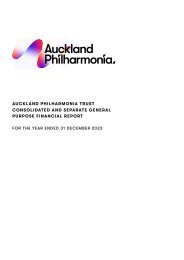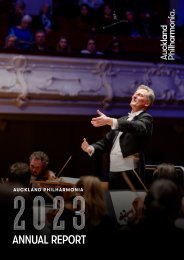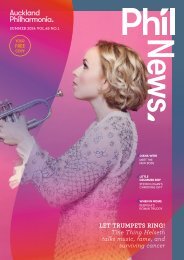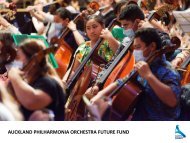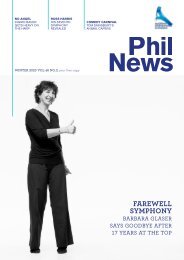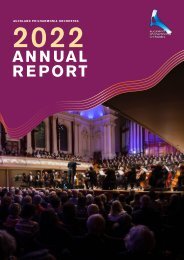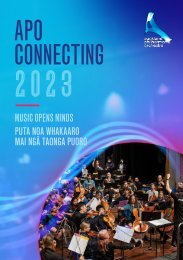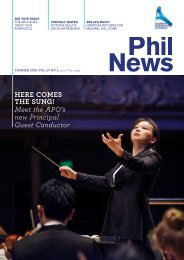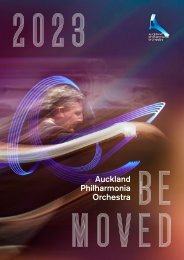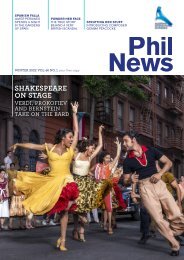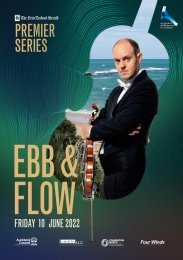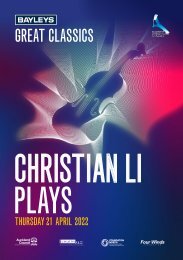You also want an ePaper? Increase the reach of your titles
YUMPU automatically turns print PDFs into web optimized ePapers that Google loves.
PREMIER<br />
SERIES<br />
LISTENING NOTES<br />
FOR EXPERIENCED LISTENERS<br />
VIOLIN Benjamin Morrison<br />
BRAHMS Violin Concerto<br />
SCHUBERT Symphony No.9 ‘<strong>The</strong> Great’
JOHANNES<br />
BRAHMS<br />
(1833 – 1897)<br />
COMPOSER PROFILE<br />
• Considered to be the leading composer of the<br />
Romantic period of music<br />
• Composed a piano sonata at age 11<br />
• Made his public debut as a conductor at age 14<br />
• Introduced to Gypsy music by Hungarian violinist<br />
Eduard Remenyi<br />
• At the age of 30, he accepted the directorship of the<br />
Vienna Singakademie<br />
• Brahms died of cancer at age 64. On the day of his<br />
funeral, all the ships in Hamburg lowered their flags to<br />
half-mast<br />
VIOLIN CONCERTO<br />
Brahms’ Violin Concerto was composed in 1878 and first<br />
performed in Leipzig, Germany. Piano and violin were the<br />
most popular solo instruments for concertos throughout<br />
the Romantic period.<br />
This piece was composed for Brahms’ friend and virtuoso<br />
violinist, Joseph Joachim. It was considered too difficult to<br />
play as it included rapid broken chords, scales and doublestopping.<br />
However, Brahms believed in Joachim’s abilities,<br />
and the Concerto was intended for Joachim to show off<br />
his virtuosity.<br />
<strong>The</strong> concerto features a cadenza at the end of the first<br />
movement, and Brahms was one of the last composers to<br />
allow the soloist to improvise it. This is because soloists<br />
began to create very long cadenzas, and eventually,<br />
composers would notate their cadenzas so that they had<br />
more control over the material that was performed.<br />
<strong>The</strong> concerto has three movements:<br />
I. Allegro non troppo<br />
II. Adagio<br />
III. Allegro gigocoso ma non troppo vivace<br />
<strong>The</strong> first movement is in Sonata form. It starts with a long<br />
introduction and the first theme presented by the orchestra.<br />
Next, the theme develops and moves into a quiet section<br />
which leads to the second theme. After this second<br />
theme, the solo violin finally enters, taking us through the<br />
development and exposition before the solo violin plays the<br />
cadenza, leading us to the final coda section.<br />
<strong>The</strong> second movement has three sections. <strong>The</strong> first section<br />
begins with the melody in the solo oboe, accompanied by<br />
the orchestra. <strong>The</strong> solo violin then takes over the melody,<br />
and this moves us into the passionate second section.<br />
Finally, the orchestra returns with the first section melody<br />
and solo violin to round off this movement.<br />
<strong>The</strong> last movement is in rondo form, where the ‘A’ section<br />
of music keeps returning. <strong>The</strong> A section begins with a<br />
foot-stomping Hungarian-style theme, with the solo violin<br />
underneath. <strong>The</strong> B section starts with light solo violin and<br />
accompaniment. This turns into a series of legato scales,<br />
in which the solo violin brings in another rhythmic melody<br />
before returning to the A section.<br />
Section C begins with graceful arpeggios followed by the<br />
solo violin playing fragments from the B section before<br />
playing the main melody from section A. <strong>The</strong> coda starts<br />
with a faster tempo in a lively Turkish style in 6/8, ending<br />
with strong subito forte, staccato chords.<br />
DID YOU KNOW?<br />
Brahms began composing when he was only 11 –<br />
however, he was embarrassed by these early compositions<br />
and he destroyed all of those works as he grew older.<br />
2
FRANZ<br />
SCHUBERT<br />
(1797 – 1828)<br />
COMPOSER PROFILE<br />
• An Austrian composer from the Romantic period<br />
• Won a place in the Vienna Imperial Court chapel choir<br />
at age 10<br />
• After leaving school in 1815, Schubert followed his<br />
father into teaching. He did not enjoy this job, and he<br />
spent all of his free time composing.<br />
• <strong>The</strong> same year he started teaching, he wrote his<br />
famous ‘Gretchen am Spinnrade’ (‘Gretchen at her<br />
spinning wheel’)<br />
• He composed 145 lieder (songs), his Second and Third<br />
Symphonies, two sonatas and a series of miniatures for<br />
solo piano, two mass settings and other shorter choral<br />
works, four stage works, and a string quartet<br />
• <strong>The</strong> only public concert Schubert gave was on<br />
26 March, 1828. It was such an artistic and financial<br />
success that Schubert at last purchased a piano<br />
• He died in 1828 at age 31, of typhoid from drinking<br />
tainted water<br />
SYMPHONY NO.9 ‘THE GREAT’<br />
<strong>The</strong> title ‘<strong>The</strong> Great’ was applied by a 19th-century<br />
publisher to distinguish between this symphony and<br />
Schubert’s earlier work of 1818. Today, ‘<strong>The</strong> Great’ has<br />
become an accepted part of the work’s title. Schubert’s<br />
Ninth Symphony has four movements:<br />
I. Andante<br />
II. Andante con moto<br />
III. Scherzo (Allegro vivace)<br />
IV. Allegro vivace<br />
<strong>The</strong> first movement, Andante (C major) starts with an<br />
unaccompanied theme from unison horns for eight bars.<br />
This is followed by the strings playing a rhythmic triple<br />
figure. <strong>The</strong> theme is then passed around the orchestra.<br />
<strong>The</strong> section continues to explore themes and assembled<br />
rhythmic material.<br />
Finally, as the Andante moves towards its close, you can<br />
hear a fragment of what is to become the Allegro first<br />
subject or theme. As the Andante is brought to a full<br />
orchestral close, the Allegro section follows immediately.<br />
Strings, trumpets, and timpani introduce the Allegro’s<br />
first theme. <strong>The</strong>n, as the theme continued, it is linked by<br />
triplets in the woodwind.<br />
After seventeen bars, Schubert introduces a second<br />
theme – dotted crotchet-quaver – rising and falling, with<br />
the woodwind and horns playing a triplet rhythm. Finally,<br />
the movement’s third theme is introduced by oboes and<br />
bassoons, accompanied by violin arpeggios, and it then<br />
develops.<br />
<strong>The</strong> final Coda of this section is marked ‘Piu Moto’ (more<br />
movement). It starts with the second theme in the strings,<br />
with an accompanying triplet figure. <strong>The</strong> movement ends<br />
with the introductory horn theme played by the full orchestra.<br />
<strong>The</strong> second movement, Andante con moto is slow, however<br />
the ‘con moto’ direction creates a march-like character. It<br />
is possible that Schubert was influenced by the Allegretto<br />
movement of Beethoven’s Seventh Symphony.<br />
This movement has four sections – A minor, F major, A<br />
minor and A major – and four main themes. Beethoven’s<br />
movement also opens in A minor. <strong>The</strong> oboes play the<br />
theme first, followed by the clarinets, violins and violas,<br />
moving to an orchestral climax. Next, the oboes and<br />
clarinets enter with the second theme. This theme is<br />
slightly slower, but within six bars, the strings break in with<br />
a third theme, with a military feel.<br />
<strong>The</strong> second and third themes are developed and enriched<br />
until four minims and a descending third in the lower<br />
strings introduce the fourth theme. Lyrical and more<br />
sonorous, this theme is played by the bassoons, second<br />
violins and basses, with a syncopated counterpoint in the<br />
cellos. <strong>The</strong> movement ends quietly, with harmony from the<br />
three trombones.<br />
3
<strong>The</strong> third movement, Scherzo opens in C major, with the<br />
first theme played by staccato strings. A second feature of<br />
the movement is the waltz themes that keep appearing –<br />
the first of these constitutes the second theme.<br />
<strong>The</strong> second section opens in A-flat major and starts with<br />
dotted minim chords in the woodwinds and brass, with a<br />
staccato string accompaniment. <strong>The</strong> section ends with<br />
two sforzando chords back in C major.<br />
<strong>The</strong> Trio section starts in A major. Horns, clarinets,<br />
bassoons and trumpets playing in octaves for eight<br />
bars and the movement’s fourth theme is played by a<br />
woodwind choir. <strong>The</strong> theme is doubled in thirds and<br />
sixths, a harmony Schubert liked to use throughout the<br />
symphony. Next, the flutes and bassoons reprise the Trio’s<br />
opening theme. <strong>The</strong> Trio repeats back to the Scherzo to<br />
finish that movement.<br />
<strong>The</strong> final movement, Allegro vivace, has two main themes.<br />
This movement opens in the symphony’s tonic key of C<br />
major. This movement is in Sonata form and has two main<br />
themes. <strong>The</strong> first theme begins with a call to attention,<br />
with fortissimo C’s in octaves. <strong>The</strong> second theme also has<br />
a running rhythm in the strings while the woodwinds play<br />
the melody.<br />
<strong>The</strong>re are extensions of this theme until both main<br />
themes are heard again in their entirety – the<br />
development section deals with fragments of<br />
the themes instead of the entire theme itself.<br />
<strong>The</strong> recapitulation repeats all the elements of<br />
the two themes. A coda section expands some of the<br />
melodic material with a short episode where strings,<br />
horns and bassoons play an accented C for four bars<br />
with the full orchestra answering in different keys. <strong>The</strong><br />
coda is unusually long, being 180 bars. <strong>The</strong> movement’s<br />
introductory rhythm returns before a sforzando C major<br />
chord that fades away to the end.<br />
DID YOU KNOW?<br />
In March 1827, Schubert was a torchbearer at<br />
Beethoven’s funeral.<br />
4



